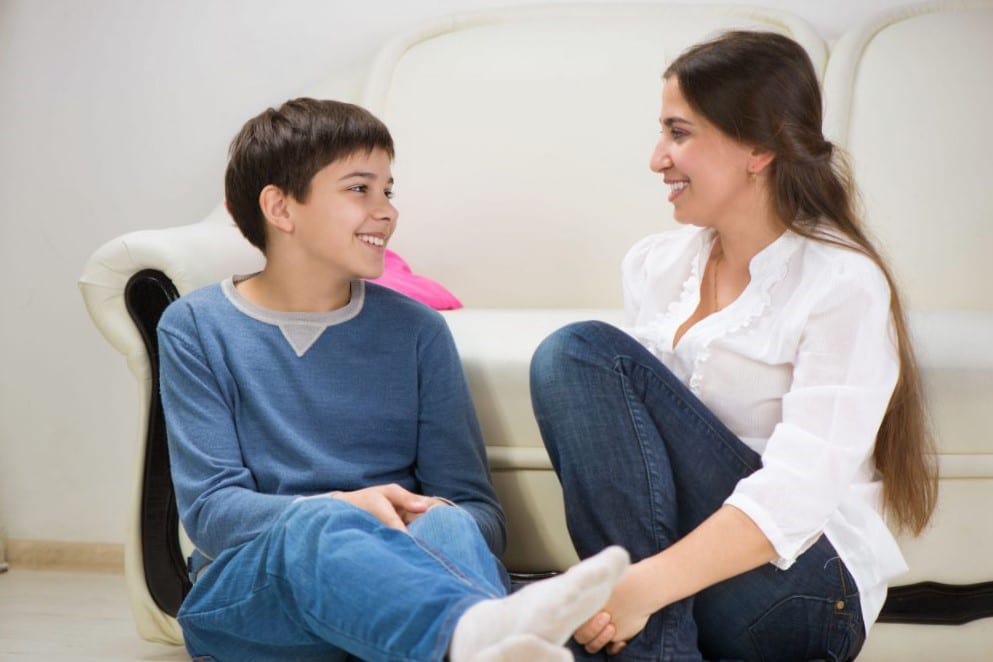How to answer simple questions from our children
Adapt answers

We offer the article “Answering simple (but at the same time complex) questions from our children” by Mª Elena Marsal and Ignacio Olivera, published in Protect Your Heart, a leading program in character and sexuality education in Europe and Latin America.
***
Cecilia was in the car with her 5 children on the way to the club, when Diego, the oldest of them, only 7 years old, asked her – Mom, is the middle finger on your hand a bad finger? -.
Sometimes parents are not prepared for all the questions that occur to our children, but it is very good that they trust us to clear their doubts and find an answer that satisfies them.
Given the questions, there are 3 alternatives:
1. Evade by pretending that nothing was heard and move on to another topic or leave the situation for later with phrases like: “I’ll explain it to you later”…
2. Responding incorrectly, telling half-truths or things that are not true
3. Respond clearly and truthfully. Certainly, it is not easy to answer them the truth because we do not know to what extent they will be ready to understand it, but what is certain is that we must answer. If we pretend that we are not listening or leave it for later and do not comply, our child will interpret that his questions do not interest us. In the future he will choose not to ask us anything and will search directly on the Internet [1] and if we waste those moments of curiosity, we will lose her trust and with it the possibility of positively influencing their lives.
Understand the context
– Tell me, Diego, why are you asking me if the middle finger is a bad finger? –Cecilia asked him, while she thought about how she could answer a simple but at the same time complex question.
Questioning guides us toward what our children seek to know and why. We can run the risk of overindulging in information that they are not looking for at that moment. It can be “left over” and confuse them more.
Another thing to keep in mind is the dialogue, a back and forth of ideas, so that the child does not get bored of listening only to us throughout the explanation.
– My cousin Valeria told me. But I don’t understand why, and she doesn’t know either – Diego answered.
The truth, but adapted to their ages
The good thing about sharing questions and answers with children is that the little ones can learn from the doubts of the older ones and, if parents know how to take advantage of those moments, the children will know that they can always come to them to answer their concerns.
Cecilia thinks it is correct to explain to her son the reason why society considers the middle finger an offense, so that he can understand it and know that the rules of coexistence and good education have a foundation, a reason. If so, they do not exist just because.
Provide positive arguments and ideas linked to the central theme
It is extremely enriching for the education of children, to take advantage of the moment of the question to instill in children other ideas, also positive, linked to the central axis of the conversation.
– Diego, you don’t show your private parts to everyone.
– Nooo mom! What a shame! – She commented.
– That’s right Diego, but in addition to being ashamed, it would be a very rude act towards yourself and other people, because the private parts are private and no one has to see them, you take care of them, you respect them, and you don’t bother others or make fun of them they-.
– Yes, mom, but what does that have to do with the finger?
For children to be able to incorporate the arguments, it is necessary to resort to certain everyday parallels so that it is easier for them to remember them. If the explanation is too theoretical, it will be difficult for them to retain the information and remember the answer.
–The middle finger is a very useful finger, isn’t it?-,
– Yes – answered the boy.
– It is a finger like any other finger on the hand, which we use to write, eat, paint, play. However, some people use it with bad intentions, identifying it with the penis, which is an intimate part of the male.
The silence in the car was the same as the silence at home at 2 a.m. when everyone sleeps. Cecilia doubted whether she had done well in giving him that answer, because she was not sure if her son would be able to interpret it correctly. She waited for him to respond, but nothing happened.
Once we start with an argument, the ideal is to finish the idea in a simple, concrete and always truthful way. Make the child understand the explanation. Leaving it like that, without making sure that he understood, could be dangerous because we are not sure if our son’s concern was answered or if he interpreted it differently.
As nothing happened, Cecilia cut the silence, and to help her son deduce the answer, she said:
– Some people, when they are angry or dissatisfied with something that happens to them, use a sign made with that finger to offend, as if they were showing their private part in a rude and disrespectful way. Since you wouldn’t show your private parts when you’re angry, you shouldn’t make that gesture either.
“That’s why the cousin said he was ugly,” the boy concluded.
Letting him find an answer himself will make him incorporate the idea and be able to remember it more easily, although due to his age, he may forget the explanation and have to repeat it again at some point.
Conclude an idea conveyed with a short phrase. And repeat it several times.
It is recommended that the question ends with the most important and conclusive ideas, to ensure that the child understood, since depending on the personality of each one (some more communicative than others), they may not tell us if they did not understand well or they may shame to say that it was not clear to them.
Since they were already arriving at their destination, Cecilia thought it was important to end the explanation with short and concrete ideas.
– So Diego, the middle finger is not an ugly or bad finger. It’s a finger like any other. People use it as rudeness when they are angry, as if they were showing an intimate part in a rude way, wanting to annoy or offend, and that’s the ugly part.
The boy nodded.
“All parts of the body are good, but the use we make of them is what makes the act ugly or bad,” Cecilia finally said, and she repeated it again.
After that conversation, Diego did not ask again about the middle finger, but he did tell his parents when he saw that other children used it rudely, which shows that he perfectly understood the meaning of the gesture. .
Giving our children the answers is not an easy task. These are not things we learn at university. Children do not come with a question and answer manual, but that is not a problem, because fortunately we have the tools to overcome this difficulty.
How to do it?
1. With practice: You learn to respond by responding. Always. Even if at that moment we do not have the answer, we can ask them for time to give it to them, explain to them that we want to give them a good answer, and we want to take some time, for example: “Look son, I want to answer you well because that question is very interesting, I would like to think carefully.” the answer and give it to you with complete certainty.
And slowly but surely, think about it carefully and not take long.
2. Dedicating time and space to dialogue with them: To comply with the previous recommendation, it is necessary to spend time with our children. Many parents say that they do not spend a lot of time, but they do spend quality time because they take them to the movies, to the field or share a sport. That’s fine, but we must keep in mind that children’s questions and doubts arise after spending time with them, in relaxed moments, car rides, an afternoon of games, a few hours sharing. Trust is created by dealing with them. If we spend little time together, trust takes longer to build. If they are watching a movie, playing soccer, or watching a tennis match, they may not ask us questions. It is necessary to be with them, share meals, baths (especially small children), everyday moments and make ourselves available (no cell phone, no TV).
3. With training: Go to parenting courses, workshops, talks whenever we can. Read books. In many materials for parents, real cases are presented, like Cecilia’s, which help us learn to give answers. They will open our minds and make it easier for us to speak naturally and without the questions causing us stress.
[1] Article “Be the Google of your children”, by Mª Luisa Estrada de Velez and Juan Francisco Velez (www.protegetucorazon.com/se-google-hijo).
 (EN)
(EN)
 (ES)
(ES)
 (IT)
(IT)





